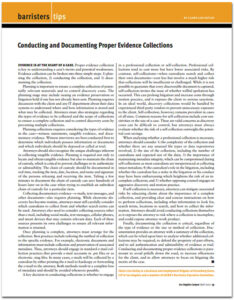Conducting and Documenting Proper Evidence Collections
 Los Angeles Lawyer
Los Angeles Lawyer
by Claire-Lise Kutlay
April 2020
EVIDENCE IS AT THE HEART OF A CASE. Proper evidence collection is key to understanding a case’s merits and potential weaknesses. Evidence collection can be broken into three simple steps: 1) planning the collection, 2) conducting the collection, and 3) documenting the collection.
Planning is important to ensure a complete collection of potentially relevant materials and to control discovery costs. The planning stage may include issuing an evidence preservation or litigation hold if one has not already been sent. Planning requires discussion with the client and any IT department about their data systems to understand where and how information is stored and what may be collected. Attorneys must also strategize regarding the types of evidence to be collected and the scope of collections to ensure a complete collection and to control discovery costs by preventing multiple collections.
Planning collections requires considering the types of evidence in the case—witness statements, tangible evidence, and documentary evidence. Witness interviews are best conducted first to determine which individuals possess information or documents and which individuals should be deposed or called at trial.
Attorneys should also recognize the unique challenges inherent in collecting tangible evidence. Planning is required not only to locate and obtain tangible evidence but also to maintain the chain of custody, which is critical to prevent challenges to its authenticity or admissibility. The chain of custody should be documented in real time, tracking the item, date, location, and name and signature of the persons releasing and receiving the item. Taking a few minutes to document the chain of custody can save hundreds of hours later on in the case when trying to establish an unbroken chain of custody for a particular item.
Collecting documentary evidence—e-mails, text messages, and other documents—also requires planning. While electronic discovery has become routine, attorneys must still carefully consider which custodians to collect from and whether search terms can be used. Attorneys also need to consider collecting sources other than e-mail, including social media, text messages, cellular phones, and smart devices that may contain relevant data. Each of these sources presents its own challenges to ensure all relevant information is retained.
Once planning is complete, attorneys must arrange for the collection. Best practices include tailoring the method of collection to the specific evidence. For example, electronic documents and information must include collection and preservation of associated metadata. Thus, attorneys should engage in standard e-mail collection practices that provide e-mail accounts in .pst files or as electronic .msg files. In many cases, e-mails will be collected by a custodian by either printing the e-mail to hardcopy or forwarding the e-mail to the attorney. Both methods result in a complete loss of metadata and should be avoided whenever possible.
A key decision in conducting collections is whether to engage in a professional collection or self-collection. Professional collections tend to cost more but have lower associated risks. By contrast, self-collections—when custodians search and collect their own documents—cost less but involve a much higher risk that collections will be insufficient or challenged. While it is not possible to guarantee that every discoverable document is captured, self-collection invites the issue of whether willful spoliation has occurred. This can prolong litigation and increase costs through motion practice, and it exposes the client to serious sanctions. In an ideal world, discovery collections would be handled by experienced third-party vendors to prevent unnecessary exposure to the client. Self-collection, however, remains prevalent in cases of all sizes. Common reasons for self-collection include cost-sensitivities or the size of a case. These are valid concerns as discovery costs can be difficult to control, but attorneys must always evaluate whether the risk of a self-collection outweighs the potential cost savings.
When analyzing whether a professional collection is necessary, attorneys should consider 1) the complexity of the collection and whether there are any unusual file types or data repositories involved; 2) the size of the collection, including the number of custodians and expected size of the data; 3) the importance of maintaining metadata integrity, which can be compromised during self-collections as most custodians are inexperienced at collecting intact metadata; 4) the custodian’s role in the litigation, including whether the custodian has a stake in the litigation or his conduct may have been embarrassing which heightens the risk of an in – complete collection; and 5) whether opposing counsel engages in aggressive discovery and motion practice.
If self-collection is necessary, attorneys can mitigate associated risks by educating clients about the importance of a complete collection, and providing clear and concise instructions on how to perform collections, including what information to look for, search terms, locations to search, and how to collect the information. Attorneys should avoid conducting collections themselves as it exposes the attorney to risk where a collection is incomplete, and could expose attorney-work product.
Finally, documenting the collection is critical, regardless of the type of evidence or the size or method of collection. Documentation provides an attorney with a summary of the collection, which can be relied upon later to analyze whether additional collections may be required, to defend the propriety of past efforts, and to aid authentication and admissibility of evidence at trial. Conducting and documenting proper evidence collections is paramount to avoid pitfalls down the road, to increase efficiencies for the client, and to allow attorneys to focus on litigating the merits of the case.
 Claire-Lise Kutlay is a business and employment litigator at
Claire-Lise Kutlay is a business and employment litigator at
Greenberg Gross LLP in Los Angeles and a member of
LACBA’s Barristers Executive Committee.
Download Article as PDF

